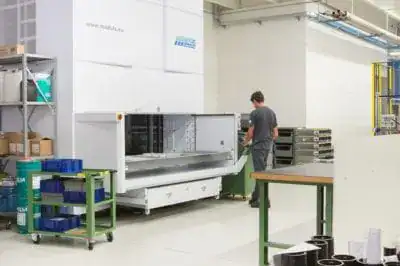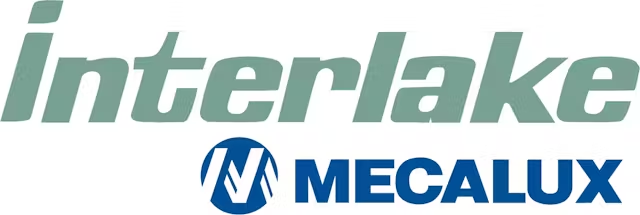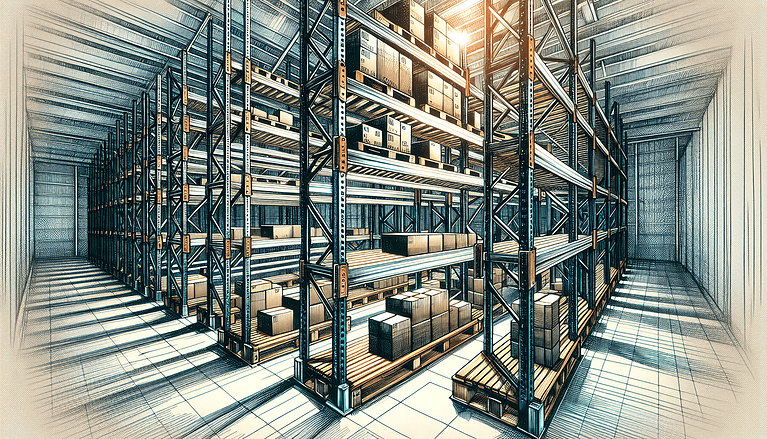Pick-to-Light Systems: 5 Powerful Reasons You Need This Tech
Cut your picking errors by 67% and double your picking speed. That’s not a warehouse manager’s fantasy – it’s a reality of pick to light. Pick to light systems really do make the order fulfillment process better.
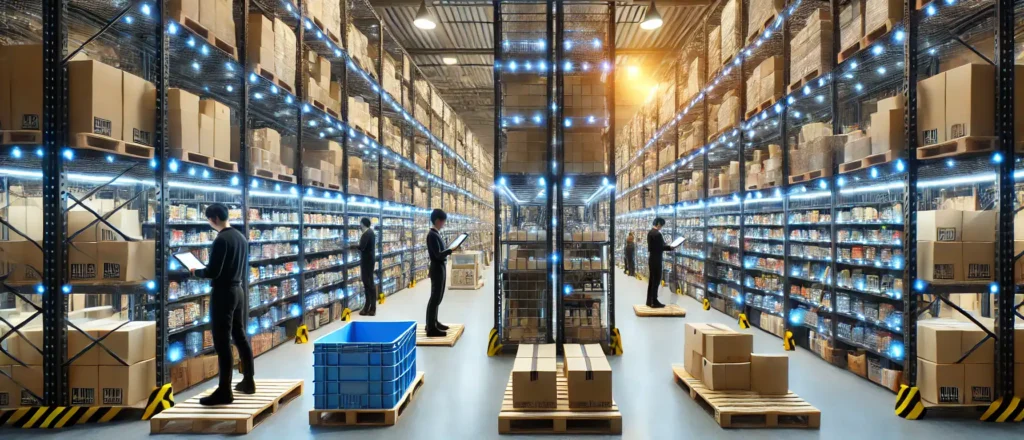
Introduction
In today’s fast-paced warehousing world, every second counts, and every error costs. As e-commerce continues to grow and customer expectations for rapid order fulfillment grow, warehouse managers are under increasing pressure to optimize their picking processes.
Enter Pick to Light – a game-changing technology that lights the way to order fulfillment better.
Pick-to-light systems are advanced order-picking technologies that use LED lights and digital displays to guide warehouse workers through picking.
These systems light the way, showing pickers where to go, what to pick, and what quantity, without paper lists or handheld devices.
But pick-to-light systems are more than just guiding pickers. They transform warehouses by reducing errors, speeding up the picking process, simplifying training, and providing real-time inventory updates.
From e-commerce giants to small specialty retailers, businesses across industries are using pick-to-light to stay ahead of the game.
This guide will cover everything you need to know about Pick to Light. We’ll look at how they work, the benefits, applications, implementation, and even the future of this technology.
Whether you’re looking to upgrade your warehouse or just want to know what’s new in logistics, this post will help you see why pick-to-light is the future of order fulfillment.
Understanding Pick-to-Light Systems
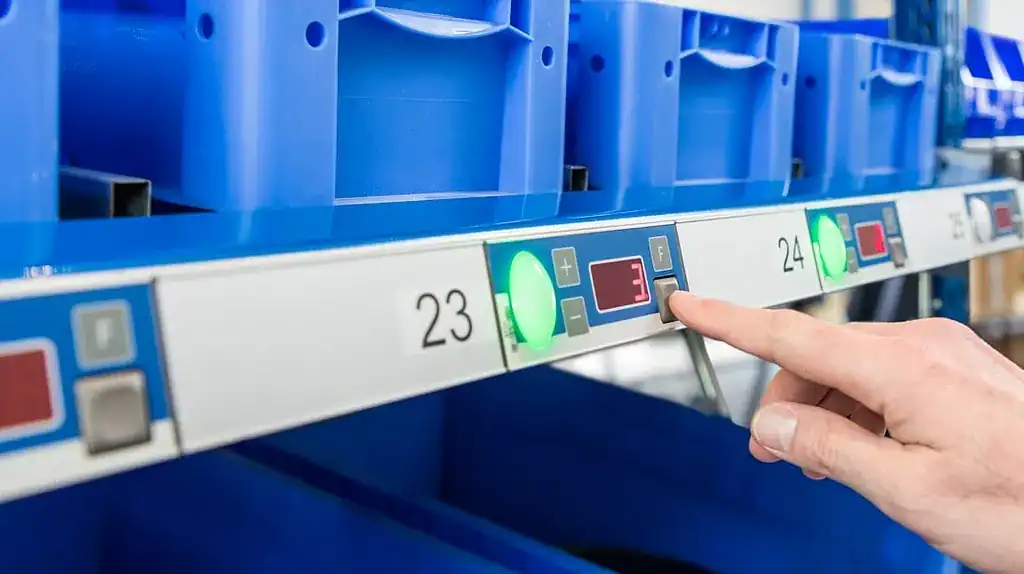
Before we get into the benefits and applications, let’s understand pick-to-light systems and how they work.
How Pick-to-Light Systems Work
Pick-to-light systems work on a simple principle:
- Order Processing: When an order is received, the system’s software processes it and determines what needs to be picked.
- Light Activation: LED lights at the relevant storage locations light up and guide the selector to the correct location for the items.
- Display Information: A digital display shows the quantity to pick.
- Confirmation: The picker confirms the pick by pressing a button that turns off the light.
- Order Completion: This repeats until all items for the order are picked.
Pick-to-Light System Components
A pick-to-light system consists of the following:
- Light Devices: Scalable, versatile indicators with optional touch buttons, optical sensors, three-digit displays, and customizable colors and animation. These light devices are attached to shelving or storage locations and are ideal for industries such as automotive, logistics, and material handling for improved speed, productivity, and quality in picking and kitting applications.
- Central Control Unit: The brain of the system that processes orders and controls the light modules.
- Confirmation Buttons: Allow pickers to confirm picks and turn off the lights.
- Software Interface: Integrates with existing Warehouse Management Systems (WMS) or Enterprise Resource Planning (ERP) systems.
- Scanning Devices: Used to initiate orders or confirm picks in some configurations.
Pick-to-Light Configurations
Pick-to-light systems can be configured in various ways:
- Static: Lights are fixed to specific storage locations.
- Dynamic: Light modules can be moved to different locations as inventory changes.
- Put-to-Light: A reverse process for sorting items into individual orders, also known as a put-to-light system. Alphanumeric displays show the correct location for each item to be placed and acknowledge the task is complete.
- Pick-to-Display: Uses larger displays for more complex picking instructions.
- RF-based: Pick to light with radio frequency for added flexibility.
Now that you understand the basics let’s get into the benefits of pick-to-light systems.
Benefits of Pick-to-Light
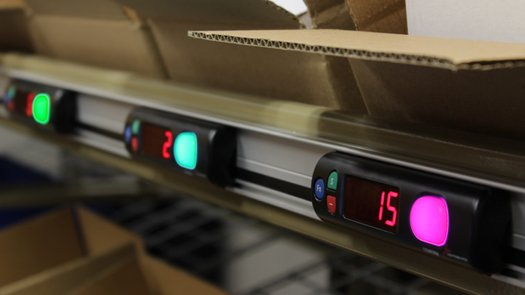
Pick-to-light systems offer many benefits that can transform your warehouse. Let’s get into the details:
Improved Picking Accuracy
- Reduced Human Error: By showing pick locations and quantities through light signals, the system reduces the chance of picking the wrong item or quantity.
- Real-time Error Detection: Immediate feedback to catch mistakes before they become shipping errors.
- Typical Improvement: Many warehouses see accuracy rates of 99.9% after implementing pick-to-light.
Faster Picking
- Simplified Process: Pickers don’t have to read and interpret pick lists or scan barcodes for each item.
- Optimized Path: The system can guide pickers through the warehouse in the most efficient way.
- Typical Improvement: Picking speeds can be 50% to 200% faster than paper-based systems.
Reduced Training Time
- Intuitive Interface: The light and button system is easy for new employees to learn.
- Language Independent: Visual cues overcome language barriers and make it easier to train a diverse workforce.
- Typical Improvement: Training time can be reduced by up to 75% compared to traditional picking methods.
Inventory Control
- Real-time Updates: Each pick confirmed updates inventory in the system.
- Visibility: Managers can see progress and productivity in real time.
- Stock Management: Accurate date inventory data prevents stockouts and overstock.
Scalability and Flexibility
- Modular: Most pick-to-light systems can be expanded or reconfigured as needed, making them suitable for various pick-to-light applications in different warehouse sizes and order volumes.
- Multi-Order Picking: Many systems support batch picking for multiple orders at once.
- Integration: Pick-to-light systems can be integrated with other warehouse technologies to provide a full solution.
Worker Satisfaction
- Reduced Physical Strain: Less carrying and consulting of pick lists or scanning devices.
- Clear Task Definition: Workers know what to do next, less stress and confusion.
- Performance Feedback: Many systems provide immediate feedback on picking performance so workers can track their productivity.
Cost Savings
Labor Efficiency: Increased picking speed and accuracy often lead to significant cost savings through lower labor costs.
Reduced Errors: Fewer picking mistakes mean less money spent on returns and reshipping, which reduces labor costs.
Optimized Space Usage: Some pick-to-light configurations can help optimize warehouse layout and space utilization.
By leveraging these benefits, warehouses can significantly improve their operations, leading to higher customer satisfaction, reduced costs, and improved market competitiveness.
Ideal Applications for Pick-to-Light Systems

Pick-to-light systems can benefit many warehouses but are ideal for certain applications. Pick to Light is easy to use, system integrated, efficient, paperless, accurate, and has low labor costs. Let’s get into the scenarios where they are perfect for:
E-commerce Fulfillment
- High volume, small item orders: Ideal for many small orders typical in e-commerce.
- Fast turnaround times: Meets same-day or next-day shipping requirements.
- Seasonal peaks: Scales to handle holiday or promotional periods.
Example: An online cosmetics retailer uses Pick to Light to manage thousands of daily orders, each containing multiple small items.
Retail Distribution
- Store replenishment: Pick items for multiple store locations.
- Mixed-SKU pallets: Build pallets with multiple products for different stores.
- Just-in-time inventory: Support lean inventory with accurate and fast picking.
Example: A fashion retailer uses Pick to Light to send daily shipments to hundreds of stores, each with a different product mix.
Manufacturing Kitting
- Assembly line supply: Pick components for manufacturing processes.
- Custom product assembly: Pick for made-to-order products.
- Quality control: Reduce component selection errors and improve product quality.
Example: An automotive parts manufacturer uses pick to light to assemble custom order kits for different car models.
Food and Beverage Distribution
- Perishable goods handling: Fast turnover of items with short shelf life.
- Temperature-controlled environments: Operate in cold storage areas.
- Batch picking for restaurants: Pick for multiple food service customers.
Example: A fresh produce distributor uses a pick to light in their cold storage warehouse to pick up restaurant orders fast and accurately.
Pharmaceutical Distribution
- High-value item picking: Accurate picking of expensive medications.
- Compliance requirements: Track and trace for regulatory compliance.
- Expiry date management: FEFO (First Expired, First Out) picking.
Example: A pharmaceutical wholesaler uses a pick to light to distribute prescription drugs to pharmacies and hospitals.
Third-Party Logistics (3PL)
- Multi-client warehousing: Adapt to different client requirements in the same facility.
- Value-added services: Custom kitting and special packaging.
- Scalability: Scale up or down to change client demands and new account onboarding.
Example: A 3PL uses a pick-to-light light system to manage multiple product ranges for more-commerce commerce clients.
When considering pick-to-light light systems, evaluate your warehouse operations, order p, profiles, and business goals. While these are the ideal scenic lights, they can be adapted to any warehouse environment.
How to Implement Pick-to-Light in Your Warehouse
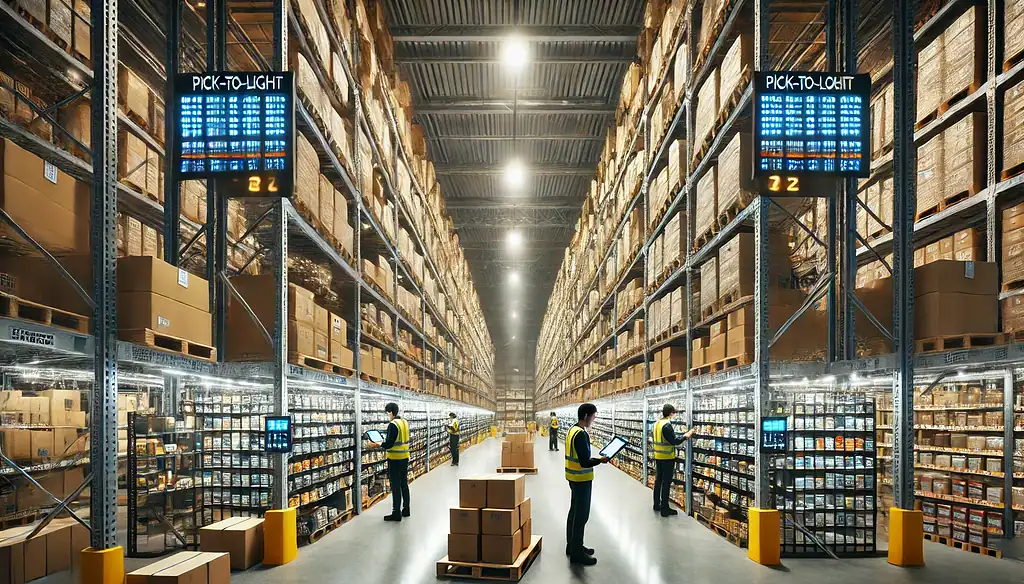
Implementing a pick-to-light system requires planning and execution. Here’s a step-by-step guide to help you get started:
Warehouse Assessment
- Assess your current picking process
- Identify bottlenecks and inefficiencies
- Measure current picking speeds and error rates
- Review order profiles and volumes
- Define your goals
- Set specific targets for improvement (e.g., 50% faster, 99% accurate)
- What’s your budget and expected ROI?
- What are your future growth and scalability needs?
- Assess your warehouse layout
- Which areas can be picked to light?
- Do you need to change the layout?
Pick to Light Solution Selection
- Research vendors
- Compare features, pricing, and support
- Read case studies and ask for references
- Flexibility
- Static or dynamic system?
- Scalability for future growth?
- Integration
- Compatible with your existing WMS or ERP system?
- Integration with a WMS to improve productivity, user experience, and order accuracy?
- Additional features like inventory management or reporting tools?
Integration with Existing Systems
- Plan the integration
- Work with your IT department and the vendor’s technical team
- Create a project plan and timeline for implementation and testing
- Data migration
- Ensure your product and location data is accurate and up to date
- Data formatting and cleaning required?
- Testing
- Thorough testing of the integrated system
- Run parallel operations for a period to ensure a smooth transition
Staff Training and Adoption
- Create a training program
- System operation and troubleshooting
- Visual aids and quick reference guides
- Pilot program
- Train a core group of staff first
- Use their feedback to refine the training
- Change management
- Communicate the benefits to all staff
- Address concerns and resistance proactively
- Continuous improvement
- Regularly gather feedback from staff
- Ongoing training and support
System Launch and Monitoring
- Phased rollout
- Single zone or product category first
- Roll out to full implementation
- Monitor key metrics
- Picking speed, accuracy, and overall productivity
- Compare to your targets
- Fine-tuning
- Adjust based on initial performance data
- Optimize pick zones and system settings as required
Installing a pick-to-light system is a big project, but with proper planning and execution, it can transform your warehouse. Remember, the key to success is thorough preparation, clear communication, and continuous optimization.
Measuring the Success of Pick to Light Systems

To ensure your pick-to-light system delivers the expected benefits, monitoring its performance closely is crucial. Here’s how to measure success and address common challenges:
Key Performance Indicators (KPIs)
Picking Accuracy
Measure: Error rate per 1000 picks
Goal: Typically 99.9% accuracy or higher
Picking Speed
Measure: Lines picked per hour
Goal: Improvement of 50-200% over previous methods
Order Cycle Time
Measure: Time from order receipt to shipment
Goal: Reduction in overall cycle time
Labor Productivity
Measure: Units picked per labor hour
Goal: Significant increase in productivity per worker
Training Efficiency
Measure: Time to train new employees to full productivity
Goal: Reduction in training time by 50-75%
Return on Investment (ROI)
Measure: Time to recoup implementation costs
Goal: Typically 12-18 months for full ROI
Common Challenges and Solutions
Challenge: Initial resistance from employees. Solution:
Involve employees in the implementation process
Highlight benefits like reduced physical strain and clearer task definition
Provide comprehensive training and support
Challenge: Integration issues with existing systems. Solution:
Conduct thorough compatibility checks before implementation
Work closely with vendors and IT teams during integration
Consider phased implementation to identify and resolve issues early
Challenge: Accuracy plateaus Solution:
Regularly review and optimize pick zones
Implement cycle counting to maintain inventory accuracy
Consider additional technologies like weight verification for high-value items
Challenge: Scalability during peak periods. Solution:
Choose a system with flexible capacity
Plan for peak periods by adding temporary light modules
Implement batch-picking strategies for high-volume periods
Challenge: Keeping up with technology advancements. Solution:
Choose a vendor with a strong R&D focus
Plan for regular system updates and upgrades
Stay informed about emerging technologies in the field
Initial employee skepticism and integration issues with their legacy WMS were challenges. These were overcome through comprehensive training programs and close collaboration with the pick-to-light vendor’s technical team.
By closely monitoring these KPIs and proactively addressing challenges, you can ensure that your pick-to-light system continues to deliver value and drive efficiency in your warehouse operations.
The Future of Pick-to-Light Technology

As warehouse technology evolves, pick-to-light systems are poised to become even more sophisticated and efficient. Let’s explore some of the emerging trends and future possibilities:
Integration with Other Technologies
Artificial Intelligence (AI) and Machine Learning
Predictive picking: AI could optimize pick sequences based on historical data and real-time orders
Adaptive systems: Machine learning algorithms could continually refine picking processes for maximum efficiency
Internet of Things (IoT)
Smart shelves: IoT-enabled shelves could communicate inventory levels directly to the pick-to-light system
Wearable tech integration: Smartwatches or AR glasses could provide additional picking guidance
Augmented Reality (AR)
Enhanced visual guidance: AR could overlay picking instructions directly onto the worker’s field of vision
Virtual training: AR could provide immersive, interactive training experiences for new employees
Voice Technology
Hybrid systems: Combining pick-to-light with voice commands for more complex picking scenarios
Multilingual support: Voice integration could further reduce language barriers in diverse workforces
Predictions for Industry Trends
Greater Customization
Modular systems: Increasingly flexible configurations to suit diverse warehouse layouts and needs
Industry-specific solutions: Tailored pick-to-light systems for sectors like pharmaceuticals or frozen foods
Enhanced Analytics and Reporting
Real-time performance dashboards: Instant visibility into picking metrics and productivity
Predictive analytics: Forecasting peak periods and optimizing staffing levels
Sustainability Focus
Energy-efficient lighting: LED technology advancements for even lower power consumption
Eco-friendly materials: More sustainable manufacturing of pick-to-light components
Mobile Pick-to-Light
Portable systems: Pick-to-light technology that can be easily moved and reconfigured
Integration with AGVs: Pick-to-light systems mounted on automated guided vehicles for dynamic picking
Cloud-Based Systems
Reduced on-premise infrastructure: Cloud-hosted pick-to-light management for easier updates and scalability
Enhanced remote management: Ability to monitor and adjust pick-to-light systems from anywhere
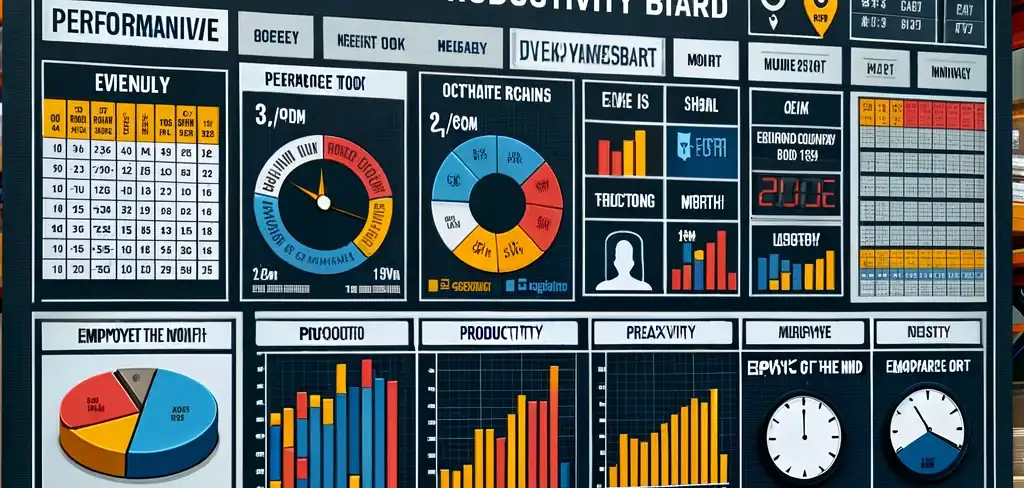
Pick-to-light systems have revolutionized warehouse operations for many businesses, offering substantial improvements in accuracy, speed, and efficiency. As we look to the future, these systems are set to become even more intelligent, flexible, and integrated with other cutting-edge technologies.
The benefits of pick-to-light are clear:
Dramatically improved picking accuracy
Significantly increased picking speed
Reduced training time and complexity
Enhanced inventory control
Improved worker satisfaction and ergonomics
As e-commerce grows and customer expectations for fast, accurate order fulfillment rise, pick-to-light systems will play an increasingly crucial role in keeping warehouses competitive and efficient.
Whether you’re managing a small distribution center or a massive fulfillment operation, pick-to-light technology offers a scalable, adaptable solution to many challenges modern warehouses face.
By staying informed about the latest developments and carefully considering your specific needs, you can leverage pick-to-light systems to illuminate the path to greater productivity and success in your warehouse operations.
Contact Warehouse Whisper today for a personalized consultation on implementing pick-to-light technology in your facility.
Our experts can help you navigate the selection, implementation, and optimization process to ensure your warehouse stays ahead of the curve in today’s competitive logistics landscape. Don’t be left in the dark—let’s brighten your warehouse’s future together!

